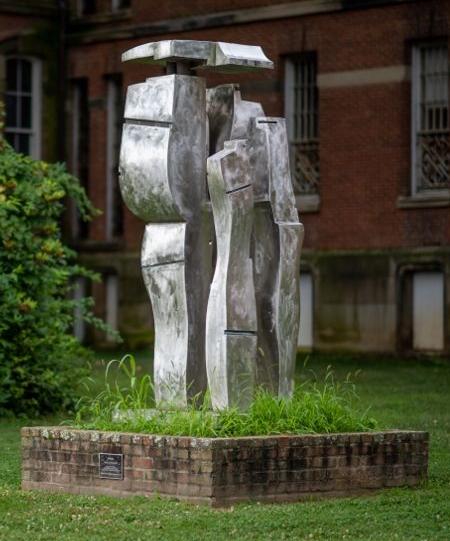
Walking Sculpture Tour, At the Ridges

| If you’ve been looking for an outdoor activity that will get you |
You will begin the tour on the front steps of the Kennedy Museum of Art and walk to the first sculpture, Family by David Deming. Stand on the front steps, facing away from the museum (toward the road/parking lot). Turn to the left and (watching for cars) follow the brick road. Once you pass the first cluster of trees and bushes, you should see the sculpture in the grass opening.

| Sculpture #1: Family by David Deming David Deming is a nationally recognized sculptor who grew |
| ACTIVITY #1: As you view the sculpture, think about and discuss the following questions with other participants: | ACTIVITY #2: After viewing Family by David Deming, you are ready to move on to the second sculpture of the tour, Gold Butte by Deborah Butterfield. As you walk, take some time to notice what’s around you. Do you see any of these things? | |
Walk around the sculpture. What do you see? | - Something blue - Something new |
To get to the second sculpture, start at the first sculpture facing away from it (toward the road). Turn to the left and continue walking along the road until you reach the end of the parking lot. Cross the street and walk up the stepped pathway between the two brick buildings. Right after passing the buildings, you should see the second sculpture in the grass off to the right.
Sculpture #2: Gold Butte by Deborah Butterfield Deborah Butterfield has been creating sculptures of horses | 
|
| Activity #3: As you view Gold Butte, imagine you are an artist and you are creating a sculpture to add somewhere near The Ridges. What materials would you use to create the piece to make it fit with other sculptures around the area? Where would you install this piece? Take a picture of where you would place your sculpture. When you get back home you can create a drawing of your site from your photograph and add your sculpture. | Both of these sculptures are part of a mAppAthens Art Stroll Tour. (opens in a new window) To connect to other tours on The Ridges, here are some links: Kid’s Nature Hike (opens in a new window) The Ridges History Loop (opens in a new window) The Ridges Land Use History Tour (opens in a new window) |
After your outdoor walking tour you can complete the activities below at The Ridges or at home!
| Activity #4: Deborah Butterfield created horse sculptures as “self portraits.” What animal would you use as your “self portrait?” Collect items from around the house or outside to create an animal sculpture that could represent your self portrait. Think about how Deborah Butterfield used sticks and metal materials to create depth and muscles in the horse sculpture. How will you use the materials to create the animal and bring it to life? What does this sculpture mean to you? | Activity #5: In his sculpture Family, David Deming uses simple shapes, lines, and curves to suggest the forms of human figures. Using paper and a writing utensil try to draw the members of your family without lifting your writing utensil from the paper (making it one continuous line). To get some really silly results, try closing your eyes while you draw. If you have craft wire at home, try making a 3D version of your line drawing! |
PDF Version (opens in a new window)

| 
|